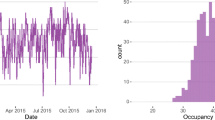Abstract
Sharing bed capacity across clinical departments improves bed availability via pooling effects. This means in effect that fewer beds are required to satisfy a given service level when combining departments and wards into groups. However, this increases the complexity of tending to inpatients and therefore creates what we term pooling costs. To solve the trade-off, we suggest an integer linear programming modeling and solution approach that is designed on a generalized set partitioning problem. The approach finds the cost-minimal combination of departments and wards in a maximum-care hospital that satisfies maximum walking distance thresholds for doctors and patients. In particular, costs associated with holding the required bed capacity are minimized while also considering seasonality of weekly demand as well as personnel qualification costs and management costs incurred by combining departments and allocating pooled ward capacity to these combinations. In addition, maximum walking distances between wards and central facilities for the combinations obtained are minimized. Our modeling and solution approach was co-developed and implemented at a large German maximum-care hospital comprising 22 clinical departments. As a result, the number of beds needed to maintain a unified service level of 95% can be reduced by 3.3%, while cutting costs by 2.1%. We also perform several sensitivity analyses and show general applicability by using simulated data for generalized and very large hospital settings.








Similar content being viewed by others
References
Best TJ, Sandıkçı B, Eisenstein DD, Meltzer DO (2015) Managing hospital inpatient bed capacity through partitioning care into focused wings. Manuf Serv Oper Manag 17(2):157–176
Bron C, Kerbosch J (1973) Finding all cliques of an undirected graph. Commun ACM 16(9):575–579
Cochran JK, Bharti A (2006) Stochastic bed balancing of an obstetrics hospital. Health Care Manag Sci 9(1):31–45
Cochran JK, Roche K (2008) A queuing-based decision support methodology to estimate hospital inpatient bed demand. J Oper Res Soc 59(11):1471–1482
De Bruin A, Bekker R, Van Zanten L, Koole GM (2010) Dimensioning hospital wards using the erlang loss model. Ann Oper Res 178(1):23–43
Fügener A, Hans EW, Kolisch R, Kortbeek N, Vanberkel PT (2014) Master surgery scheduling with consideration of multiple downstream units. Eur J Oper Res 239(1):227–236
Green LV, Ngyuen V (2001) Strategies for cutting hospital beds: the impact on patient service. Health Serv Res 36(2):421–442
Hall R (ed) (2012) Handbook of healthcare system scheduling. International series in operations research & management science. Springer, Heidelberg
Harris RA (1986) Hospital bed requirements planning. Eur J Oper Res 25(1):121–126
Helber S, Böhme D, Oucherif F, Lagershausen S, Kasper S (2015) A hierarchical facility layout planning approach for large and complex hospitals. Flex Serv Manuf J 28:5–29
Hof S, Fügener A, Schoenfelder J, Brunner J (2015) Case mix planning in hospitals: a review and future agenda. Health Care Manag Sci 20:207–220
Hübner A, Walther M, Kuhn H (2016) Approach to clustering clinical departments. In: Matta A, Sahin E, Li J, Guinet A, Vandaele NJ (eds) Health care systems engineering for scientists and practitioners. Springer proceedings in mathematics & statistics, Lyon, pp 111–120
Prim RC (1957) Shortest connection networks and some generalizations. Bell Syst Tech J 36(6):1389–1401. https://doi.org/10.1002/j.1538-7305.1957.tb01515.x
Van Essen TJ, Van Houdenhoven M, Hurink JL (2015) Clustering clinical departments for wards to achieve a prespecified blocking probability. OR Spectr 37(1):243–271
Vassilacopoulos G (1985) A simulation model for bed allocation to hospital inpatient departments. Simulation 45(5):233–241
Wolsey LA, Nemhauser GL (1999) Integer and combinatorial optimization. Wiley, New York
Acknowledgements
The authors are grateful to the Klinikum Ingolstadt, i.e., the case hospital that we collaborated with on this project, for their support and many helpful contributions. A special thanks to Erich Göllner, Stefan Hosch, Rainer Knöferl, Mirela Leuca, Andreas Manseck and Holger Mulitza and their valuable recommendations, which significantly improved our research. In addition, we would like to thank the anonymous reviewers and the Area Editor and Editor of ORS for their highly valuable recommendations, which have significantly improved our paper.
Author information
Authors and Affiliations
Corresponding author
Rights and permissions
About this article
Cite this article
Hübner, A., Kuhn, H. & Walther, M. Combining clinical departments and wards in maximum-care hospitals. OR Spectrum 40, 679–709 (2018). https://doi.org/10.1007/s00291-018-0522-6
Received:
Accepted:
Published:
Issue Date:
DOI: https://doi.org/10.1007/s00291-018-0522-6




